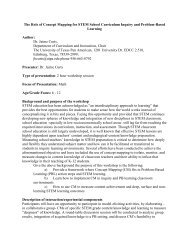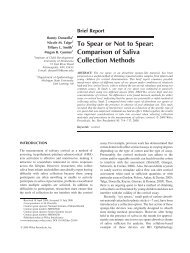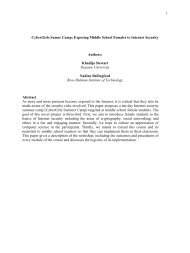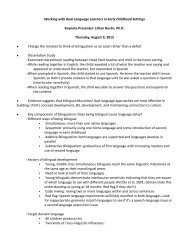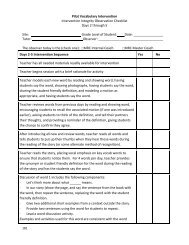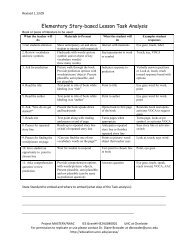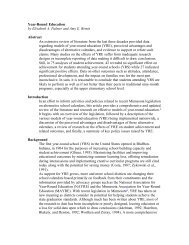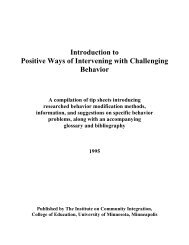Trauma and the Developing Brain - College of Education & Human ...
Trauma and the Developing Brain - College of Education & Human ...
Trauma and the Developing Brain - College of Education & Human ...
Create successful ePaper yourself
Turn your PDF publications into a flip-book with our unique Google optimized e-Paper software.
H<strong>and</strong>out for <strong>Trauma</strong>, The <strong>Developing</strong> <strong>Brain</strong>, Healing <strong>and</strong> Emotional Regulation Seminars<br />
Karina A. Forrest-‐Perkins MHR LADC, 2011<br />
The Neurobiological Responses to Threat<br />
When a child is threatened, various neurophysiological <strong>and</strong> neuroendocrine responses are<br />
initiated. If <strong>the</strong>y persist, <strong>the</strong>re will be ‘use-‐dependent’ alterations in <strong>the</strong> key neural systems<br />
involved in <strong>the</strong> stress response. These include <strong>the</strong> hypothalamic-‐pituitary-‐adrenal (HPA) axis.<br />
In animal models, chronic activation <strong>of</strong> <strong>the</strong> HPA system in response to stress has negative<br />
consequences. Chronic activation may "wear out" parts <strong>of</strong> <strong>the</strong> body including <strong>the</strong> hippocampus,<br />
a key area involved in memory, cognition <strong>and</strong> arousal. This may be occurring in traumatized<br />
children as well. Dr. Martin Teicher <strong>and</strong> colleagues have demonstrated hippocampal/limbic<br />
abnormalities in a sample <strong>of</strong> abused children.<br />
Ano<strong>the</strong>r set <strong>of</strong> neural systems that become sensitized by repetitive stressful experiences are<br />
<strong>the</strong> catecholamine systems including <strong>the</strong> dopaminergic <strong>and</strong> noradrenergic systems. These key<br />
neurochemical systems become altered following traumatic stress. The result is a cascade <strong>of</strong><br />
associated changes in attention, impulse control, sleep, fine motor control <strong>and</strong> o<strong>the</strong>r<br />
functions mediated by <strong>the</strong> catecholamines.<br />
As <strong>the</strong>se catecholamines <strong>and</strong> <strong>the</strong>ir target regions (e.g., amygdaloid nuclei) also mediate a<br />
variety <strong>of</strong> o<strong>the</strong>r emotional, cognitive <strong>and</strong> motor functions, sensitization <strong>of</strong> <strong>the</strong>se systems by<br />
repetitive re-‐experiencing <strong>of</strong> <strong>the</strong> trauma leads to dysregulation in many functions.<br />
A traumatized child may, <strong>the</strong>refore, exhibit motor hyperactivity, anxiety, behavioral impulsivity,<br />
sleep problems, tachycardia <strong>and</strong> hypertension. In preliminary studies by our group, we have<br />
seen altered cardiovascular regulation (e.g., increased resting heartrate) suggesting altered<br />
autonomic regulation at <strong>the</strong> level <strong>of</strong> <strong>the</strong> brainstem. In o<strong>the</strong>r studies, clonidine, an alpha2<br />
adrenergic receptor partial agonist has been demonstrated to be an effective<br />
pharmaco<strong>the</strong>rapeutic agent, presumably by altering <strong>the</strong> sensitivity <strong>of</strong> <strong>the</strong> noradrenergic<br />
systems.<br />
Implications <strong>of</strong> <strong>Trauma</strong>-‐related Alterations in <strong>Brain</strong> Development<br />
All experiences change <strong>the</strong> brain – yet not all experiences have equal ‘impact’ on <strong>the</strong> brain.<br />
Because <strong>the</strong> brain is organizing at such an explosive rate in <strong>the</strong> first years <strong>of</strong> life, experiences<br />
during this period have more potential to influence <strong>the</strong> brain – in positive <strong>and</strong> negative ways.<br />
<strong>Trauma</strong>tic experiences <strong>and</strong> <strong>the</strong>rapeutic experiences impact <strong>the</strong> same brain <strong>and</strong> are limited by<br />
3




